Exhibit 99.2

Confidential and Proprietary Apitegromab Update Data extracted April 7, 2022 Anti - Myostatin Antibody With Transformative Potential in Patients with Type 2 and Type 3 SMA
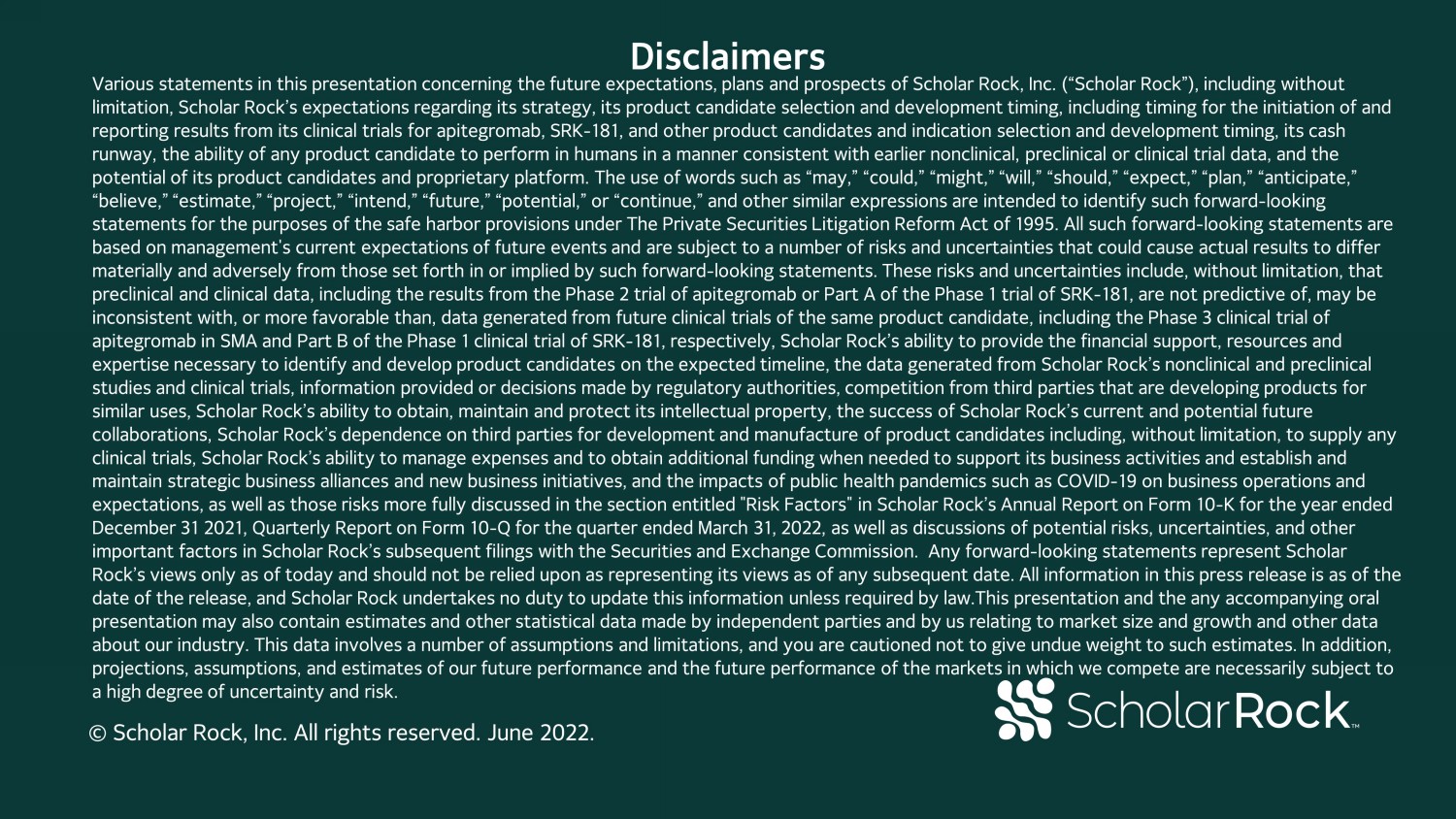
Disclaimers Various statements in this presentation concerning the future expectations, plans and prospects of Scholar Rock, Inc. (“Schol ar Rock”), including without limitation, Scholar Rock’s expectations regarding its strategy, its product candidate selection and development timing, inclu din g timing for the initiation of and reporting results from its clinical trials for apitegromab , SRK - 181, and other product candidates and indication selection and development timing, its cash runway, the ability of any product candidate to perform in humans in a manner consistent with earlier nonclinical, preclinica l o r clinical trial data, and the potential of its product candidates and proprietary platform. The use of words such as “may,” “could,” “might,” “will,” “shou ld, ” “expect,” “plan,” “anticipate,” “believe,” “estimate,” “project,” “intend,” “future,” “potential,” or “continue,” and other similar expressions are intended to identify such forward - looking statements for the purposes of the safe harbor provisions under The Private Securities Litigation Reform Act of 1995. All such forward - looking statements are based on management's current expectations of future events and are subject to a number of risks and uncertainties that could ca use actual results to differ materially and adversely from those set forth in or implied by such forward - looking statements. These risks and uncertainties in clude, without limitation, that preclinical and clinical data, including the results from the Phase 2 trial of apitegromab or Part A of the Phase 1 trial of SRK - 181, are not predictive of, may be inconsistent with, or more favorable than, data generated from future clinical trials of the same product candidate, includin g t he Phase 3 clinical trial of apitegromab in SMA and Part B of the Phase 1 clinical trial of SRK - 181, respectively, Scholar Rock’s ability to provide the financial suppo rt, resources and expertise necessary to identify and develop product candidates on the expected timeline, the data generated from Scholar Rock ’s nonclinical and preclinical studies and clinical trials, information provided or decisions made by regulatory authorities, competition from third parties th at are developing products for similar uses, Scholar Rock’s ability to obtain, maintain and protect its intellectual property, the success of Scholar Rock’s cu rrent and potential future collaborations, Scholar Rock’s dependence on third parties for development and manufacture of product candidates including, w ith out limitation, to supply any clinical trials, Scholar Rock’s ability to manage expenses and to obtain additional funding when needed to support its busine ss activities and establish and maintain strategic business alliances and new business initiatives, and the impacts of public health pandemics such as COVID - 19 on business operations and expectations, as well as those risks more fully discussed in the section entitled "Risk Factors" in Scholar Rock’s Annual Rep ort on Form 10 - K for the year ended December 31 2021, Quarterly Report on Form 10 - Q for the quarter ended March 31, 2022, as well as discussions of potential risks, uncertainties, and other important factors in Scholar Rock’s subsequent filings with the Securities and Exchange Commission. Any forward - looking stateme nts represent Scholar Rock’s views only as of today and should not be relied upon as representing its views as of any subsequent date. All informat ion in this press release is as of the date of the release, and Scholar Rock undertakes no duty to update this information unless required by law.This presentation and the any accompanying oral presentation may also contain estimates and other statistical data made by independent parties and by us relating to market s ize and growth and other data about our industry. This data involves a number of assumptions and limitations, and you are cautioned not to give undue weigh t t o such estimates. In addition, projections, assumptions, and estimates of our future performance and the future performance of the markets in which we compe te are necessarily subject to a high degree of uncertainty and risk. © Scholar Rock, Inc. All rights reserved. June 2022.

Agenda 3 SMA Disease Background & Current Treatment Landscape Apitegromab TOPAZ Extension Period: 24 - Month Data Apitegromab SAPPHIRE Phase 3 Trial Overview Business Update

4 Revolutionary Approach to Regulating Highly Sought - After Growth Factors Implicated in Devastating Diseases Scholar Rock’s Target Growth Factor Precursor (Latent Form) Scholar Rock’s R&D Platform Transform Medical Practice • Pursue important targets with well - validated biology but are difficult to drug • Apply revolutionary approach to tough targets • Leverage deep insights into structure and function • Engineer antibodies to deliver differentiated therapeutic profiles (i.e. exquisite selectivity) TOPAZ demonstrated the therapeutic potential of inhibiting the latent forms of growth factors Mature growth factors Prodomain
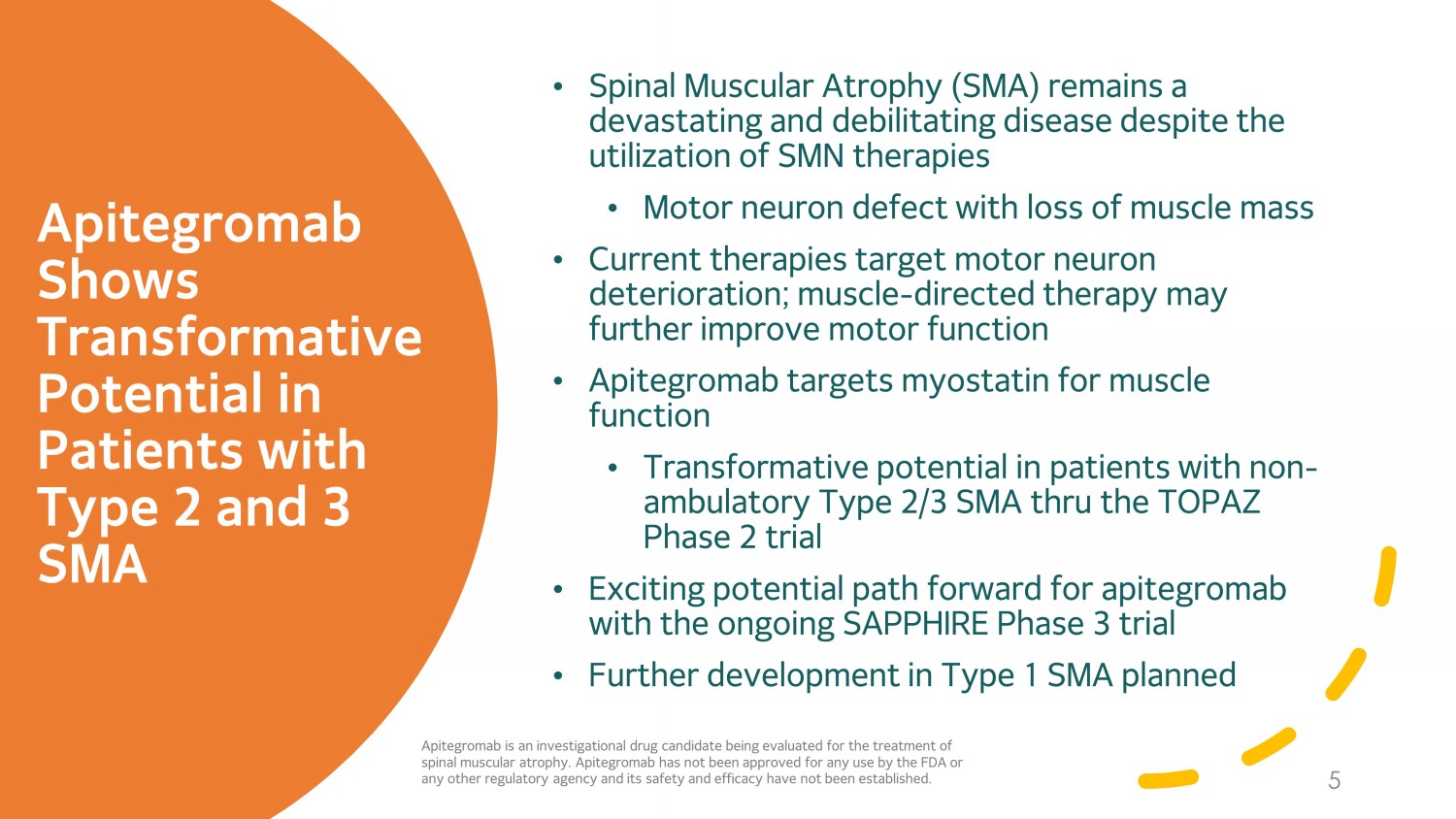
Apitegromab Shows Transformative Potential in Patients with Type 2 and 3 SMA • Spinal Muscular Atrophy (SMA) remains a devastating and debilitating disease despite the utilization of SMN therapies • Motor neuron defect with loss of muscle mass • Current therapies target motor neuron deterioration; muscle - directed therapy may further improve motor function • Apitegromab targets myostatin for muscle function • Transformative potential in patients with non - ambulatory Type 2/3 SMA thru the TOPAZ Phase 2 trial • Exciting potential path forward for apitegromab with the ongoing SAPPHIRE Phase 3 trial • Further development in Type 1 SMA planned 5 Apitegromab is an investigational drug candidate being evaluated for the treatment of spinal muscular atrophy. Apitegromab has not been approved for any use by the FDA or any other regulatory agency and its safety and efficacy have not been established.
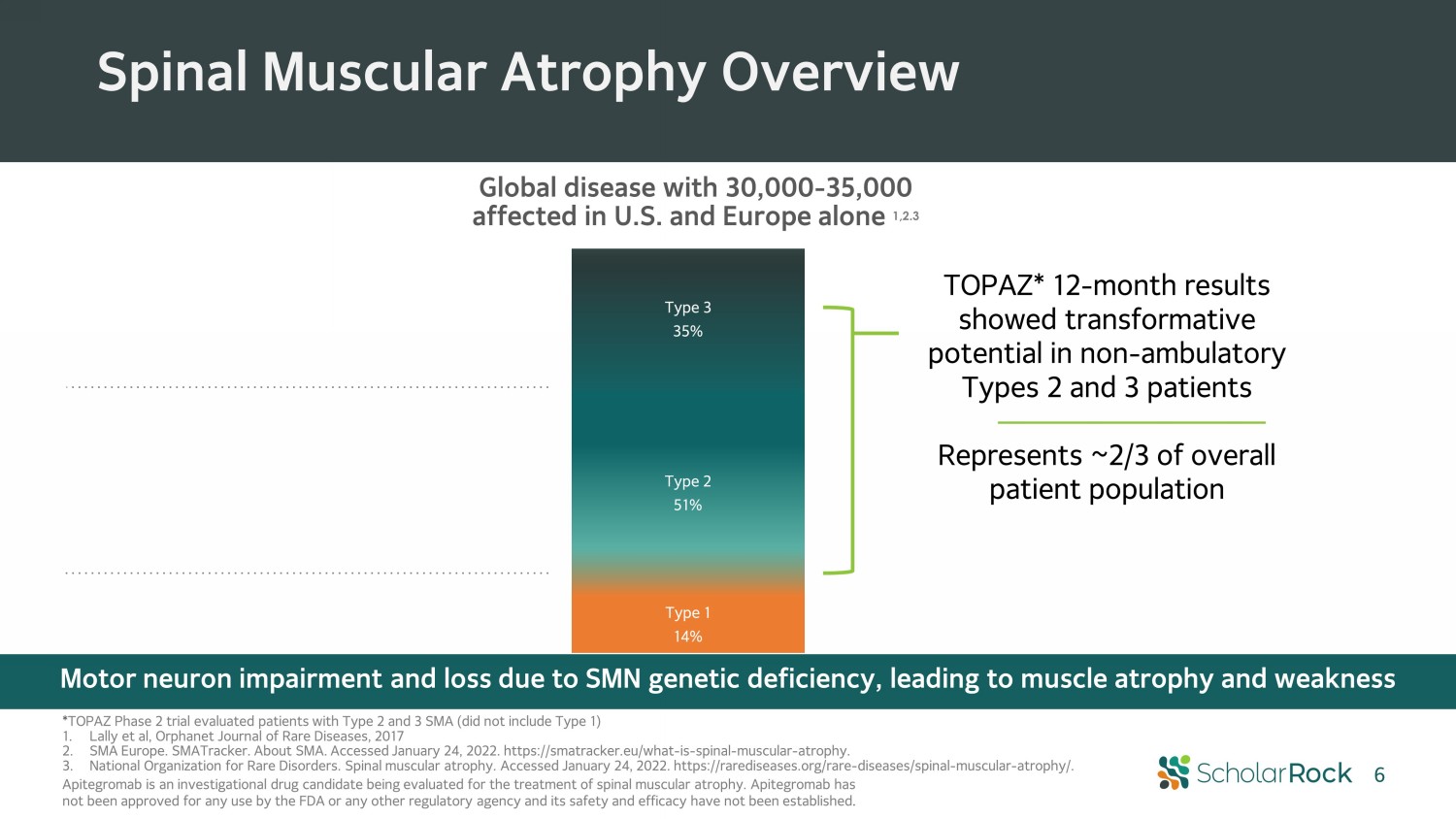
6 Spinal Muscular Atrophy Overview Type 1 14% Type 2 51% Type 3 35% Global disease with 30,000 - 35,000 affected in U.S. and Europe alone 1,2.3 TOPAZ* 12 - month results showed transformative potential in non - ambulatory Types 2 and 3 patients Represents ~2/3 of overall patient population Motor neuron impairment and loss due to SMN genetic deficiency, leading to muscle atrophy and weakness * TOPAZ Phase 2 trial evaluated patients with Type 2 and 3 SMA (did not include Type 1) 1. Lally et al, Orphanet Journal of Rare Diseases, 2017 2. SMA Europe. SMATracker. About SMA. Accessed January 24, 2022. https://smatracker.eu/what - is - spinal - muscular - atrophy. 3. National Organization for Rare Disorders. Spinal muscular atrophy. Accessed January 24, 2022. https://rarediseases.org/rare - dise ases/spinal - muscular - atrophy/. Apitegromab is an investigational drug candidate being evaluated for the treatment of spinal muscular atrophy. Apitegromab ha s not been approved for any use by the FDA or any other regulatory agency and its safety and efficacy have not been established .
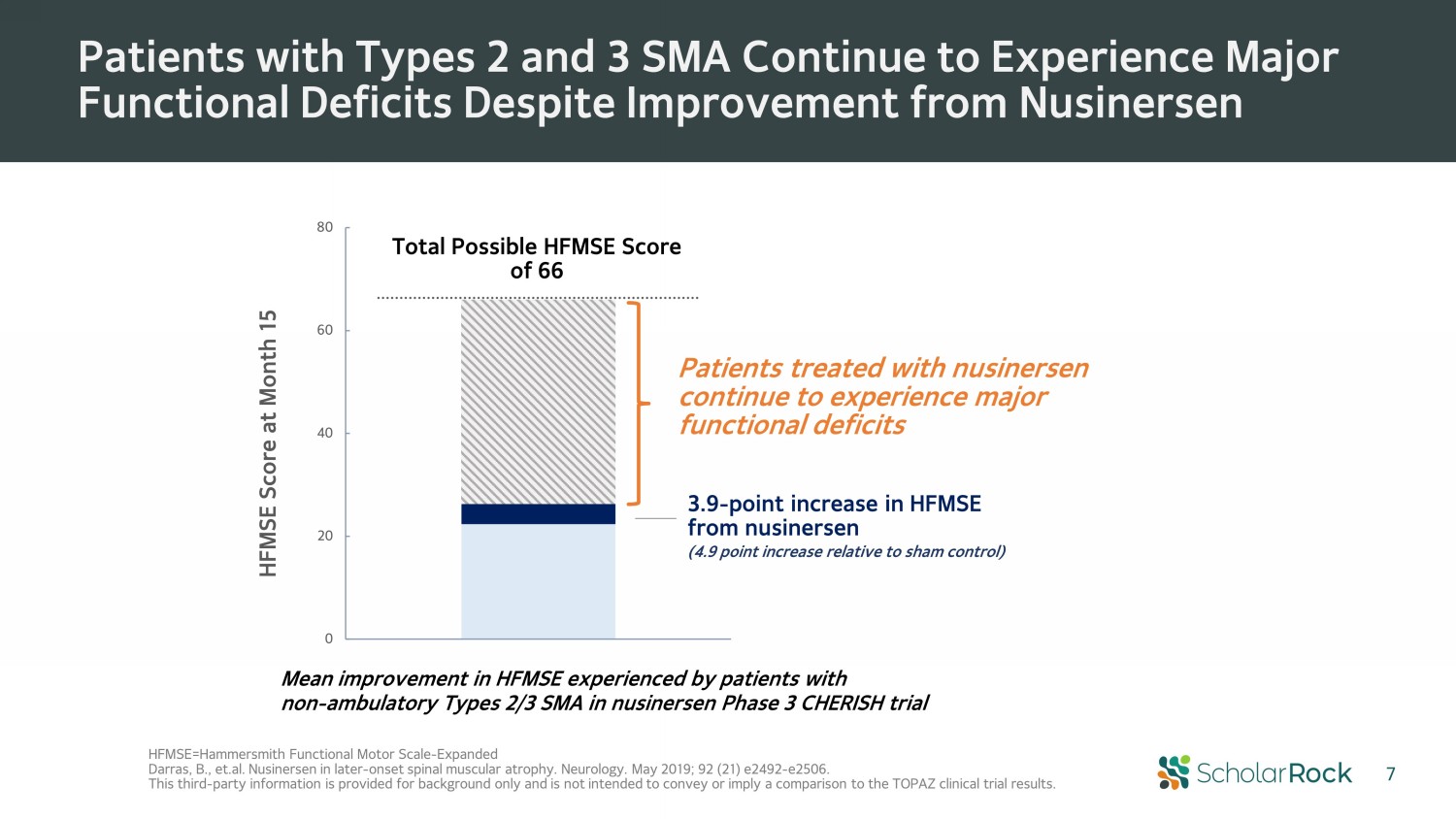
Patients with Types 2 and 3 SMA Continue to Experience Major Functional Deficits Despite Improvement from Nusinersen 7 HFMSE=Hammersmith Functional Motor Scale - Expanded Darras, B., et.al. Nusinersen in later - onset spinal muscular atrophy. Neurology. May 2019; 92 (21) e2492 - e2506. This third - party information is provided for background only and is not intended to convey or imply a comparison to the TOPAZ cl inical trial results. Mean improvement in HFMSE experienced by patients with non - ambulatory Types 2/3 SMA in nusinersen Phase 3 CHERISH trial 3.9 - point increase in HFMSE from nusinersen 0 20 40 60 80 HFMSE Score at Month 15 Total Possible HFMSE Score of 66 Patients treated with nusinersen continue to experience major functional deficits (4.9 point increase relative to sham control)

HFMSE=Hammersmith Functional Motor Scale - Expanded. 1. Mercuri E, et al. Presented at: World Muscle Society Congress 2020, P. 257 2. Oskoui M, et al. Presented at: 2021 Muscular Dystrophy Association Clinical & Scientific Conference; March 15 - 18, 2021. Poster 80. This third - party information is provided for background only and is not intended to convey or imply a comparison to the TOPAZ cl inical trial results. Plateauing of HFMSE increases observed following initial treatment effects for nusinersen Mean (+ SE) Change in HFMSE Total Score From Baseline Analysis Visit, days 1 92 169 253 350 450 690 930 1170 1410 1650 8 7 6 5 4 3 2 1 0 - 1 - 2 - 3 - 4 <1 - point increase in HFMSE after ~ first year of treatment +3.9 - points +4.6 - points Unmet Need for Motor Function Gains I nitial treatment CHERISH Chronic maintenance phase SHINE Motor Gains in Patients with Types 2 and 3 SMA on SMN Therapies Appear to Plateau After Initial Gains Plateau of HFMSE increases observed following initial treatment effect of risdiplam , although longer timeframes currently under investigation 2 Mean Change From Baseline in HFMSE Total Score † Visit, months – 1 0 1 2 3 4 0 2 4 6 8 10 18 20 22 24 16 14 12 Placebo Risdiplam RISDIPLAM 2 NUSINERSEN 1 Overall population 2 - 25 years old 8
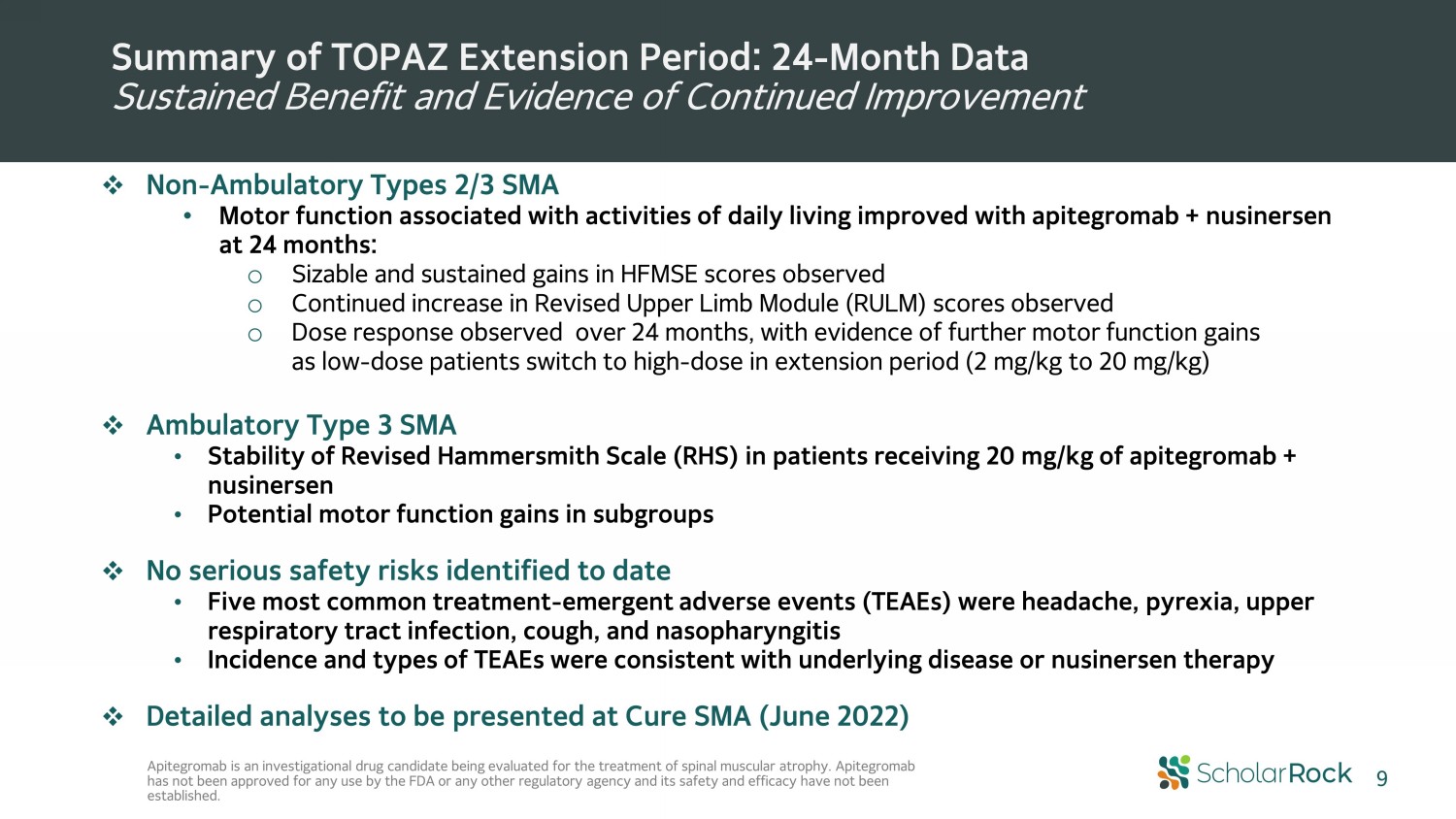
Summary of TOPAZ Extension Period: 24 - Month Data Sustained Benefit and Evidence of Continued Improvement □ Non - Ambulatory Types 2/3 SMA • Motor function associated with activities of daily living improved with apitegromab + nusinersen at 24 months: o Sizable and sustained gains in HFMSE scores observed o Continued increase in Revised Upper Limb Module (RULM) scores observed o Dose response observed over 24 months, with evidence of further motor function gains as low - dose patients switch to high - dose in extension period ( 2 mg/kg to 20 mg/kg) □ Ambulatory Type 3 SMA • Stability of Revised Hammersmith Scale (RHS) in patients receiving 20 mg/kg of apitegromab + nusinersen • Potential motor function gains in subgroups □ No serious safety risks identified to date • Five most common treatment - emergent adverse events (TEAEs) were headache, pyrexia, upper respiratory tract infection, cough, and nasopharyngitis • Incidence and types of TEAEs were consistent with underlying disease or nusinersen therapy □ Detailed analyses to be presented at Cure SMA (June 2022) 9 Apitegromab is an investigational drug candidate being evaluated for the treatment of spinal muscular atrophy. Apitegromab has not been approved for any use by the FDA or any other regulatory agency and its safety and efficacy have not been established.

Phase 2 Trial Design Apitegromab = nonproprietary name for SRK - 015 HFMSE=Hammersmith Functional Motor Scale Expanded; RHS=Revised Hammersmith Scale Data on file. Scholar Rock, Inc. Cambridge, MA Ambulatory Patients (Revised Hammersmith Scale) Non - Ambulatory Patients (Hammersmith Functional Motor Scale Expanded) Cohort 1 Cohort 2 Cohort 3 • N= 23; ages 5 - 21 • Open - label, single - arm • 20 mg/kg apitegromab IV Q4W • 12 - month treatment period • N= 15; ages 5 - 21 • Open - label, single - arm • 20 mg/kg apitegromab IV Q4W • 12 - month treatment period • N= 20; ages ≥2 • Double - blind, randomized (1:1) to 2 mg/kg or 20 mg/kg apitegromab IV Q4W • 12 - month treatment period • Ambulatory Type 3 SMA • Two subgroups: 1) Receiving nusinersen 2) Apitegromab monotherapy • Type 2 or Type 3 SMA • Receiving nusinersen (initiated at age 5 or older) • Type 2 SMA • Receiving nusinersen (initiated before age 5) • Safety • Mean change from baseline in RHS • Safety • Mean change from baseline in HFMSE • Safety • Mean change from baseline in HFMSE 10
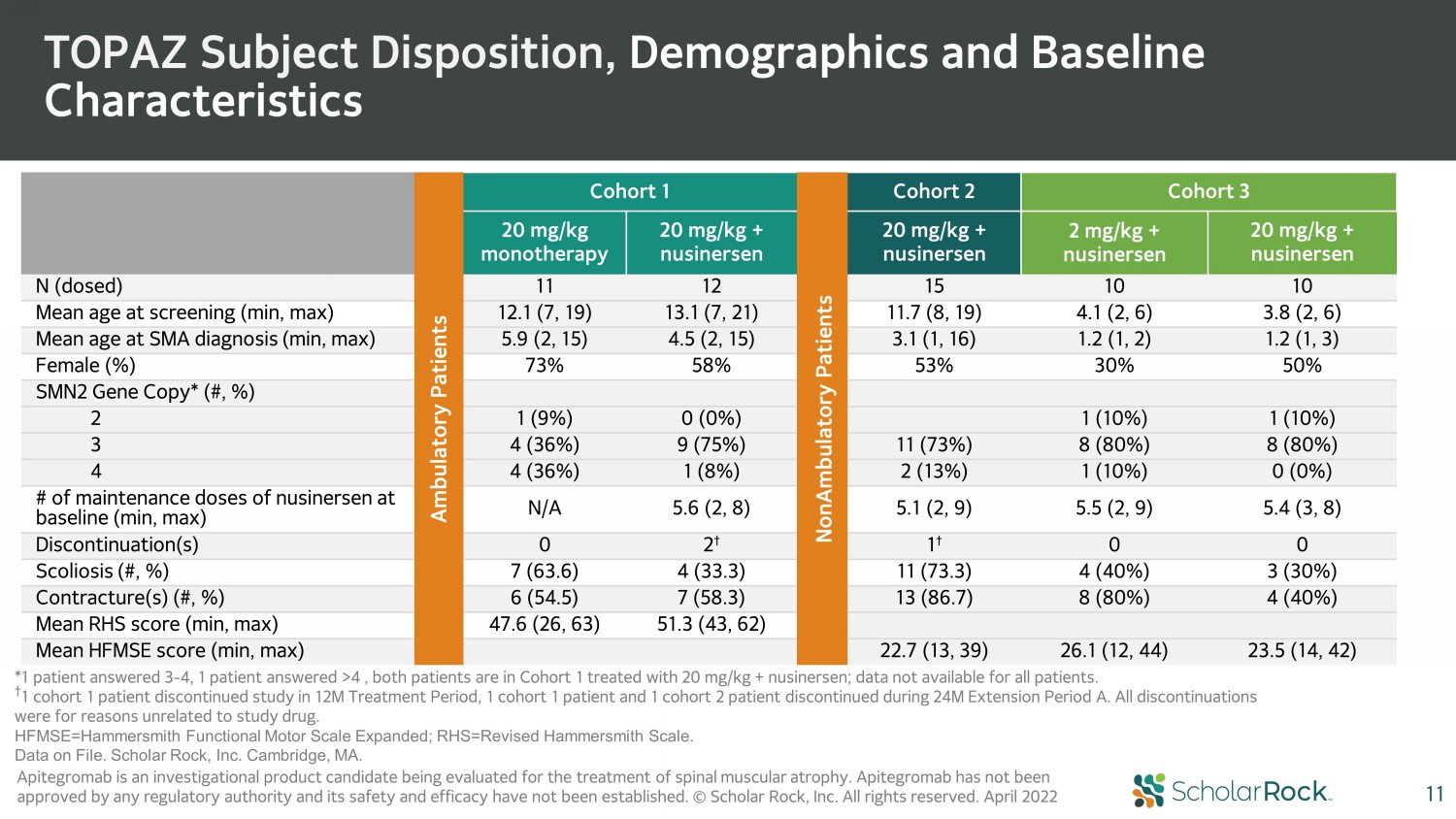
Apitegromab is an investigational product candidate being evaluated for the treatment of spinal muscular atrophy. Apitegromab ha s not been approved by any regulatory authority and its safety and efficacy have not been established. © Scholar Rock, Inc. All rights r ese rved. April 2022 TOPAZ Subject Disposition, Demographics and Baseline Characteristics *1 patient answered 3 - 4, 1 patient answered >4 , both patients are in Cohort 1 treated with 20 mg/kg + nusinersen ; data not available for all patients. † 1 cohort 1 patient discontinued study in 12M Treatment Period, 1 cohort 1 patient and 1 cohort 2 patient discontinued during 24M Extension Period A. All discontinuations were for reasons unrelated to study drug. HFMSE=Hammersmith Functional Motor Scale Expanded; RHS=Revised Hammersmith Scale. Data on File. Scholar Rock, Inc. Cambridge, MA. Ambulatory Patients Cohort 1 NonAmbulatory Patients Cohort 2 Cohort 3 20 mg/kg monotherapy 20 mg/kg + nusinersen 20 mg/kg + nusinersen 2 mg/kg + nusinersen 20 mg/kg + nusinersen N (dosed) 11 12 15 10 10 Mean age at screening (min, max) 12.1 (7, 19) 13.1 (7, 21) 11.7 (8, 19) 4.1 (2, 6) 3.8 (2, 6) Mean age at SMA diagnosis (min, max) 5.9 (2, 15) 4.5 (2, 15) 3.1 (1, 16) 1.2 (1, 2) 1.2 (1, 3) Female (%) 73% 58% 53% 30% 50% SMN2 Gene Copy* (#, %) 2 1 (9%) 0 (0%) 1 (10%) 1 (10%) 3 4 (36%) 9 (75%) 11 (73%) 8 (80%) 8 (80%) 4 4 (36%) 1 (8%) 2 (13%) 1 (10%) 0 (0%) # of maintenance doses of nusinersen at baseline (min, max) N/A 5.6 (2, 8) 5.1 (2, 9) 5.5 (2, 9) 5.4 (3, 8) Discontinuation(s) 0 2 † 1 † 0 0 Scoliosis (#, %) 7 (63.6) 4 (33.3) 11 (73.3) 4 (40%) 3 (30%) Contracture(s) (#, %) 6 (54.5) 7 (58.3) 13 (86.7) 8 (80%) 4 (40%) Mean RHS score (min, max) 47.6 (26, 63) 51.3 (43, 62) Mean HFMSE score (min, max) 22.7 (13, 39) 26.1 (12, 44) 23.5 (14, 42) 11
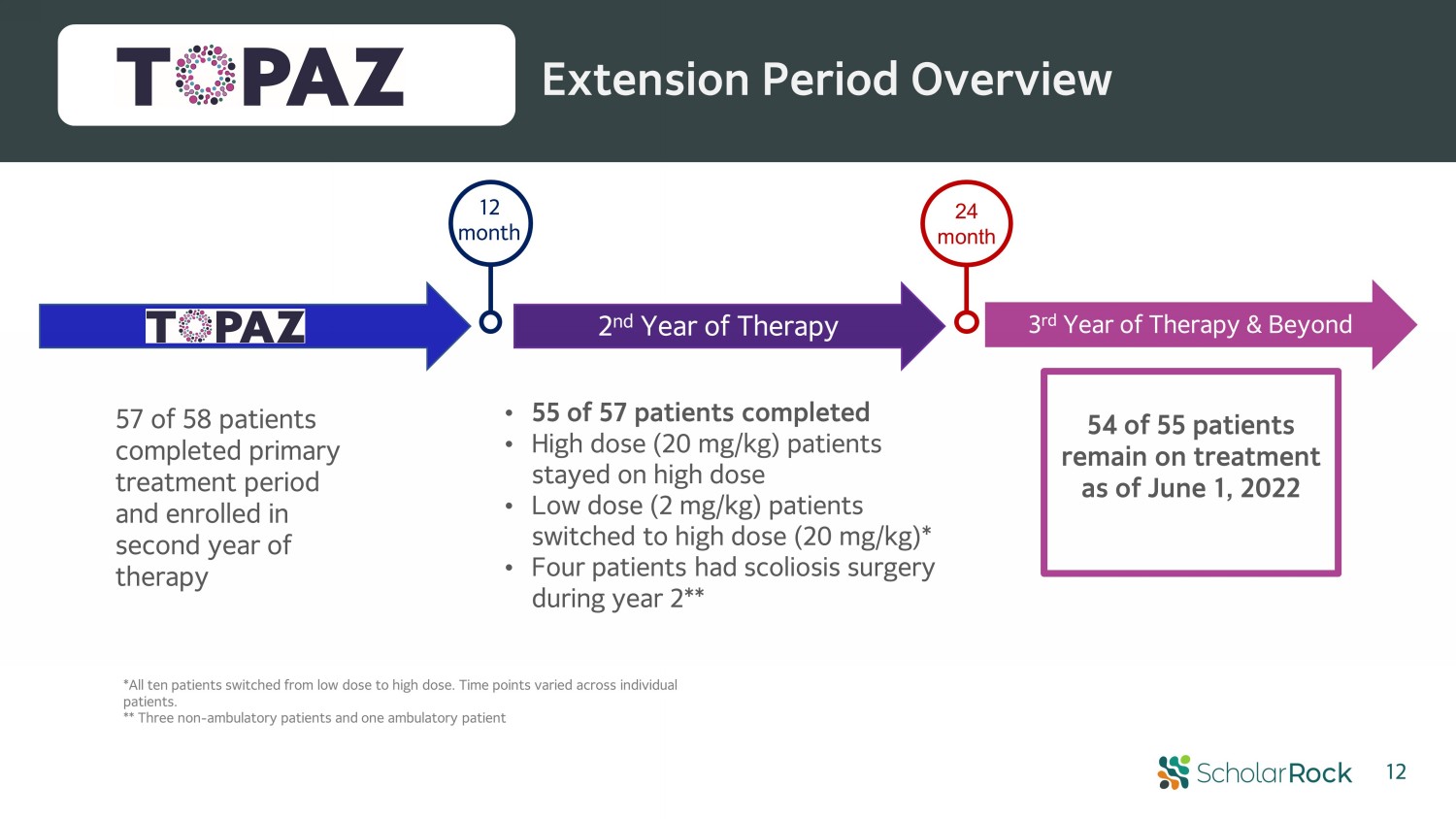
Extension Period Overview 12 month 57 of 58 patients completed primary treatment period and enrolled in second year of therapy • 55 of 57 patients completed • High dose (20 mg/kg) patients stayed on high dose • Low dose (2 mg/kg) patients switched to high dose (20 mg/kg)* • Four patients had scoliosis surgery during year 2** 3 rd Year of Therapy & Beyond 24 month 54 of 55 patients remain on treatment as of June 1, 2022 2 nd Year of Therapy 12 *All ten patients switched from low dose to high dose. Time points varied across individual patients. ** Three non - ambulatory patients and one ambulatory patient

Significance of Hammersmith Functional Motor Scale Expanded (HFMSE) Validated measure assessing the physical abilities of patients with Types 2/3 SMA o Consists of 33 items graded on a scale of 0 to 2: 0 denotes unable; 1 denotes performed with modification or adaptation; and 2 denotes without modification or adaptation. o Item scores are summed to give a total score with a maximum of 66. The higher the total score, the greater the patient’s motor function. o Examples of items: o One hand to head in sitting o Rolls supine to prone o Lying to sitting o Four – point kneeling o Supported standing o Stepping o Ascends 4 stairs with railing Able to touch head above ear level whilst maintaining stable trunk and head position Able to roll from supine to prone over the right side without pulling/pushing on hands O’Hagen et al. 2007; Glanzman et al. 2011; Hammersmith Functional Motor Scale Expanded for SMA (HFMSE) Manual, 2019 Examples of HFMSE items 13
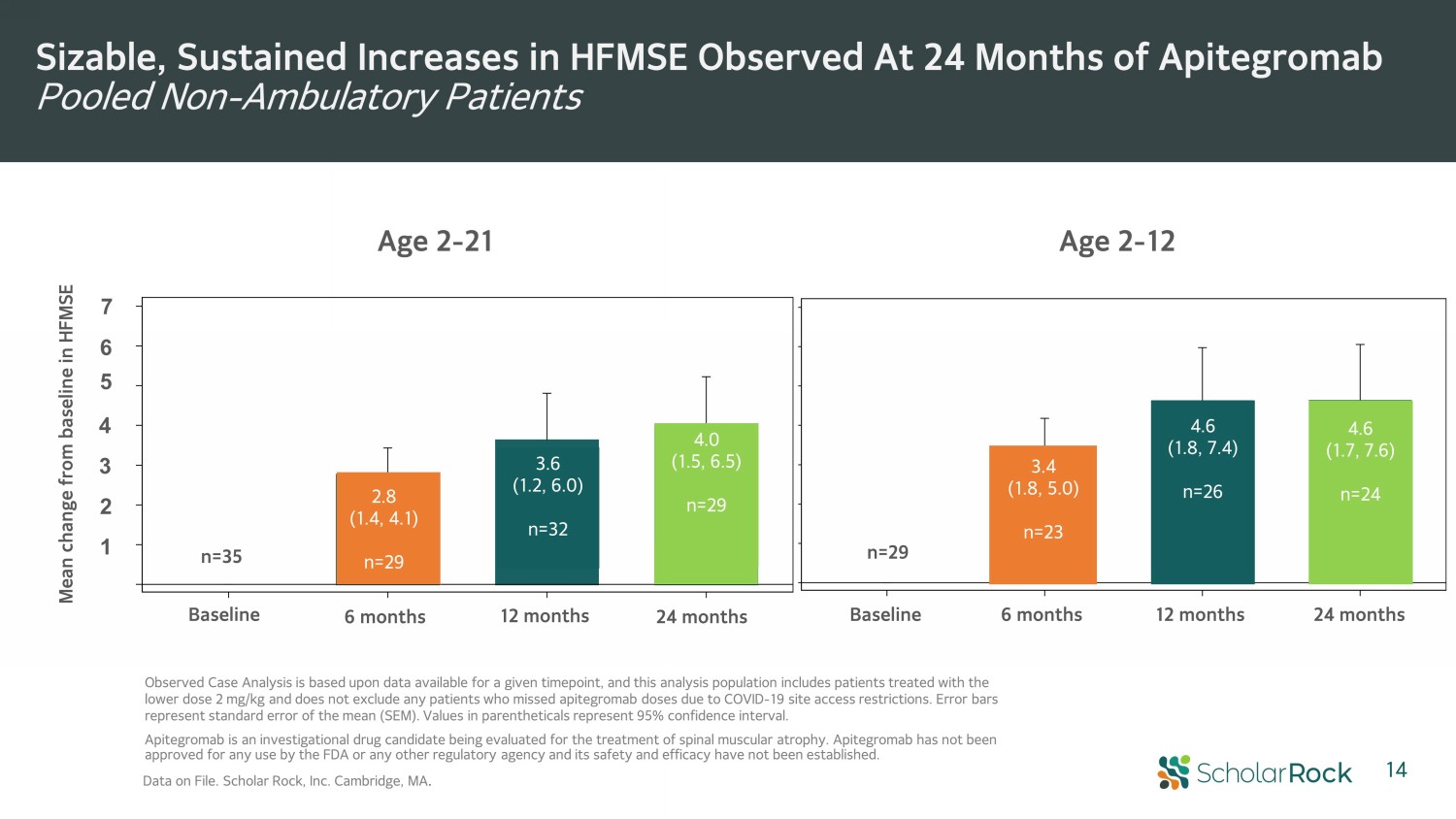
Sizable, Sustained Increases in HFMSE Observed At 24 Months of Apitegromab Pooled Non - Ambulatory Patients Data on File. Scholar Rock, Inc. Cambridge, MA . Observed Case Analysis is based upon data available for a given timepoint, and this analysis population includes patients treated with th e lower dose 2 mg/kg and does not exclude any patients who missed apitegromab doses due to COVID - 19 site access restrictions. Error bars represent standard error of the mean (SEM). Values in parentheticals represent 95% confidence interval. 14 Age 2 - 21 Age 2 - 12 3.6 (1.2, 6.0) n=32 4.0 (1.5, 6.5) n=29 n=29 n=35 6 months 12 months 24 months 6 months 12 months 24 months Baseline Baseline 1 2 3 4 5 6 7 Mean change from baseline in HFMSE Apitegromab is an investigational drug candidate being evaluated for the treatment of spinal muscular atrophy. Apitegromab ha s n ot been approved for any use by the FDA or any other regulatory agency and its safety and efficacy have not been established. 3.4 (1.8, 5.0) n=23 4.6 (1.7, 7.6) n=24 4.6 (1.8, 7.4) n=26 2.8 (1.4, 4.1) n=29

Reported Impact of Scoliosis Surgery on Motor Abilities in SMA o The vast majority of patients in this peer - reviewed study lost >3 pts on the HFMSE as assessed at least 3 months post - surgery o 14/17 participants lost >3 points (mean change = - 12.1, SD = 8.9) on the HFMSE, representing a functionally meaningful change o 3/17 participants had minimal HFMSE changes within ± 2 points (mean change = - 0.7), representing no change or stability o 0/17 participants had improvement greater than 2 points post - surgery Post - Surgery HFMSE scores Type 2/3 SMA ( Dunaway Young et al. 2020) 15
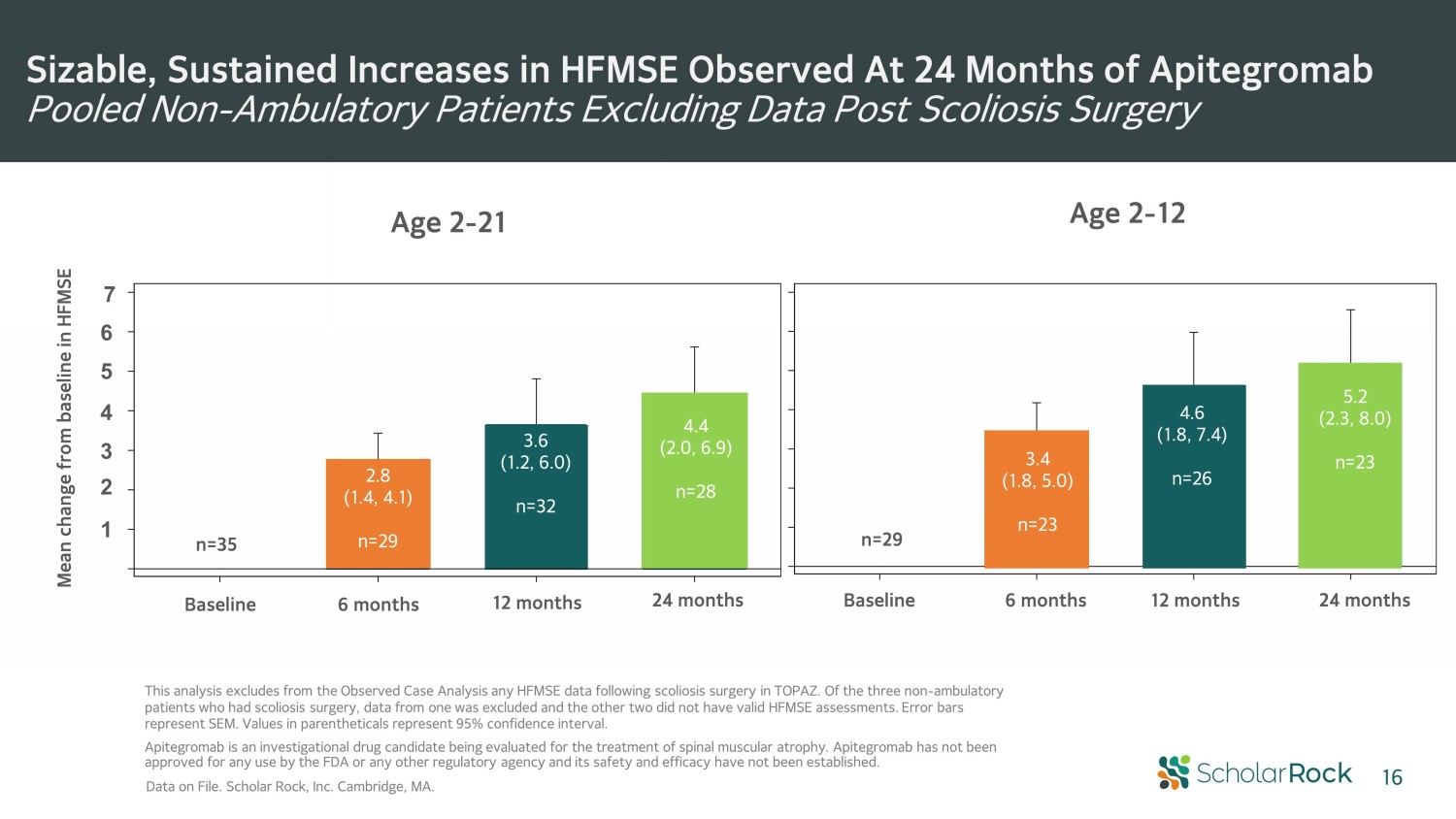
Sizable, Sustained Increases in HFMSE Observed At 24 Months of Apitegromab Pooled Non - Ambulatory Patients Excluding Data Post Scoliosis Surgery Data on File. Scholar Rock, Inc. Cambridge, MA. 16 6 months 12 months 24 months 6 months 12 months 24 months Baseline Baseline Age 2 - 12 3.6 (1.2, 6.0) n=32 n=29 n=35 1 2 3 4 5 6 7 Age 2 - 21 This analysis excludes from the Observed Case Analysis any HFMSE data following scoliosis surgery in TOPAZ. Of the three non - amb ulatory patients who had scoliosis surgery, data from one was excluded and the other two did not have valid HFMSE assessments. Error bar s represent SEM. Values in parentheticals represent 95% confidence interval. Mean change from baseline in HFMSE Apitegromab is an investigational drug candidate being evaluated for the treatment of spinal muscular atrophy. Apitegromab ha s n ot been approved for any use by the FDA or any other regulatory agency and its safety and efficacy have not been established. 2.8 (1.4, 4.1) n=29 5.2 (2.3, 8.0) n=23 3.4 (1.8, 5.0) n=23 4.4 (2.0, 6.9) n=28 4.6 (1.8, 7.4) n=26

Strong Evidence of Dose Response Observed Over 24 Months Further Supported by Data from Low Dose to High Dose Switch 20 mg/kg throughout Switched from 2 mg/kg to 20 mg/kg Dose - switching period This analysis excludes from the Observed Case Analysis the HFMSE data attained post - scoliosis surgery during TOPAZ. Error bars r epresent SEM. Apitegromab is an investigational drug candidate being evaluated for the treatment of spinal muscular atrophy. Apitegromab ha s n ot been approved for any use by the FDA or any other regulatory agency and its safety and efficacy have not been established. 17 Mean Change from Baseline in HFSME Scores Over Time (Cohort 3) Excludes data after scoliosis surgery

0 2 8 5 6 8 4 1 1 2 1 4 0 1 6 8 1 9 6 2 2 4 2 5 2 2 8 0 3 0 8 3 3 6 3 6 4 3 9 2 4 2 0 4 4 8 4 7 6 5 0 4 5 3 2 5 6 0 5 8 8 6 1 6 6 4 4 6 7 2 7 0 0 7 2 8 1 10 100 1000 10000 Time (days) M e a n ( ± S D ) L a t e n t M y o s t a t i n C o n c e n t r a t i o n ( n g / m L ) TOPAZ Cohort 1 (20 mg/kg) TOPAZ Cohort 2 (20 mg/kg) TOPAZ Cohort 3 (20 mg/kg) TOPAZ Cohort 3 (2 mg/kg) 0 2 8 5 6 8 4 1 1 2 1 4 0 1 6 8 1 9 6 2 2 4 2 5 2 2 8 0 3 0 8 3 3 6 3 6 4 3 9 2 4 2 0 4 4 8 4 7 6 5 0 4 5 3 2 5 6 0 5 8 8 6 1 6 6 4 4 6 7 2 7 0 0 7 2 8 1 10 100 1000 10000 Time (days) M e a n ( ± S D ) S R K - 0 1 5 C o n c e n t r a t i o n ( g / m L ) TOPAZ Cohort 1 (20 mg/kg) TOPAZ Cohort 2 (20 mg/kg) TOPAZ Cohort 3 (20 mg/kg) TOPAZ Cohort 3 (2 mg/kg) • Well - behaved PK profile consistent with that commonly observed with monoclonal antibodies • Drug exposure was dose proportional PK and PD Data are Consistent With Clinically Observed Dose Response Pharmacokinetics* (PK) Target Engagement [Pharmacodynamics (PD)] *Starting at day 28, measures are predose trough levels. Data on File. Scholar Rock, Inc. Cambridge, MA. • Target engagement by apitegromab was confirmed • Low - dose (2 mg/kg) yielded lower level of target engagement and did not achieve full target saturation 18 Apitegromab is an investigational drug candidate being evaluated for the treatment of spinal muscular atrophy. Apitegromab has not been approved for any use by the FDA or any other regulatory agency and its safety and efficacy have not been established.

Significance of the Revised Upper Limb Module (RULM) Evaluates Motor Performance in Upper Limbs o Evaluated upper limb tasks correspond to ability to perform everyday activities o Exc ept for 1 activity with a binary score, the items are scored 0 to 2: 0 denotes unable; 1 denotes able with modification; and 2 denotes able with no difficulty o Maximum score of 37 points (19 task items) o Examples of items: o Putting a coin into a cup o Elevating a cup to mouth o Picking up a coin o Bringing hand to shoulder o Lifting up weighted objects o Opening a zip lock bag o Drawing a line on paper Able to bring token to cup placed vertically at shoulder height Brings weight at eye level using two hands Mazzone et al. 2017; Pierzchlewicz et al. 2021; Revised Upper Limb Module for SMA Manual, 2014 Examples of RULM items 19
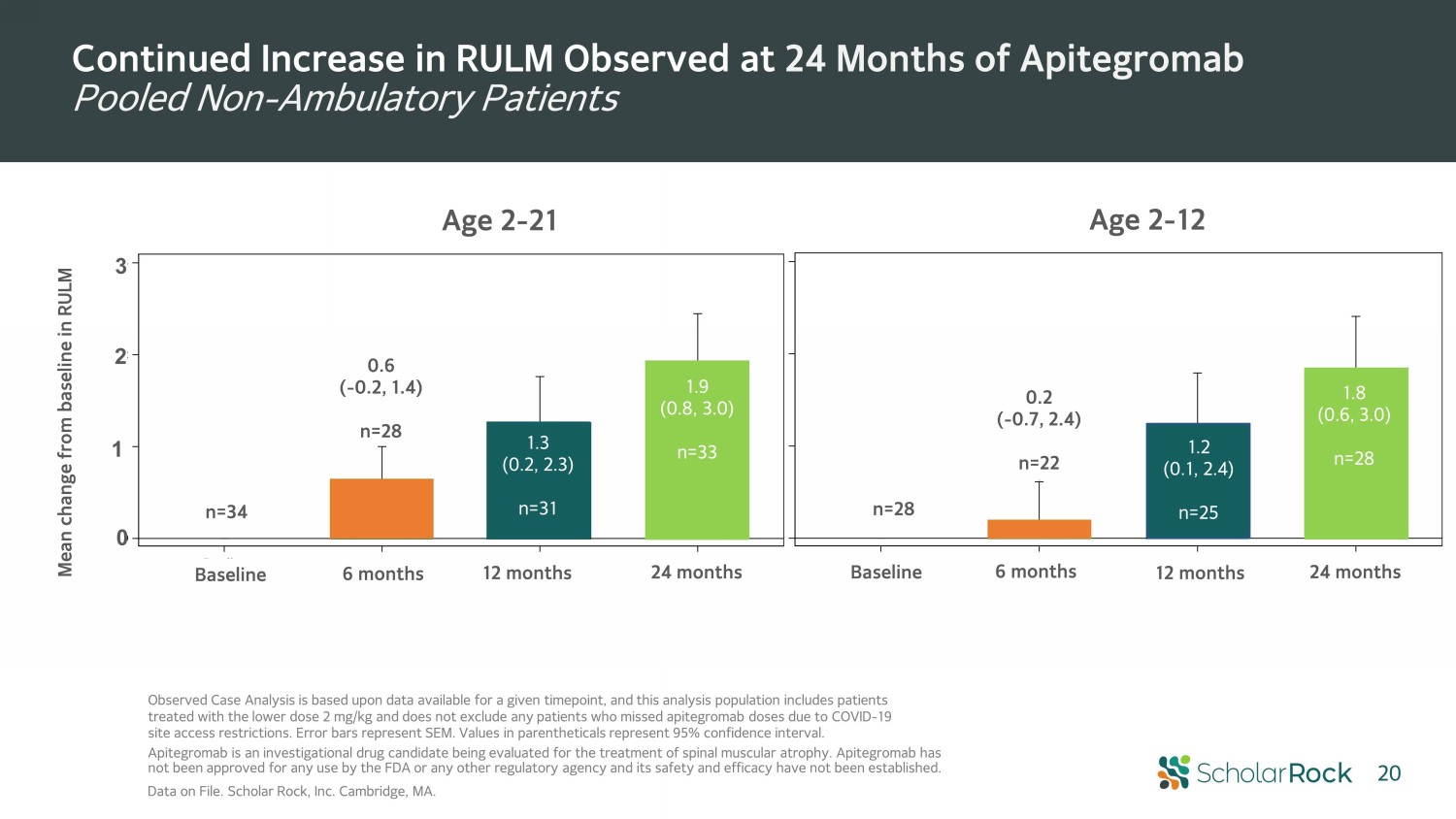
Continued Increase in RULM Observed at 24 Months of Apitegromab Pooled Non - Ambulatory Patients Data on File. Scholar Rock, Inc. Cambridge, MA. Observed Case Analysis is based upon data available for a given timepoint, and this analysis population includes patients treated with the lower dose 2 mg/kg and does not exclude any patients who missed apitegromab doses due to COVID - 19 site access restrictions. Error bars represent SEM. Values in parentheticals represent 95% confidence interval. Age 2 - 21 Age 2 - 12 12 months 24 months 6 months 0.2 ( - 0.7, 2.4) n=22 3 2 1 0 20 1.2 (0.1, 2.4) n=25 Baseline n=28 0.6 ( - 0.2, 1.4) n =28 Baseline 6 months 12 months 24 months n=28 n=34 Mean change from baseline in RULM Apitegromab is an investigational drug candidate being evaluated for the treatment of spinal muscular atrophy. Apitegromab ha s not been approved for any use by the FDA or any other regulatory agency and its safety and efficacy have not been established . 1.9 (0.8, 3.0) n=33 1.8 (0.6, 3.0) n=28 1.3 (0.2, 2.3) n=31
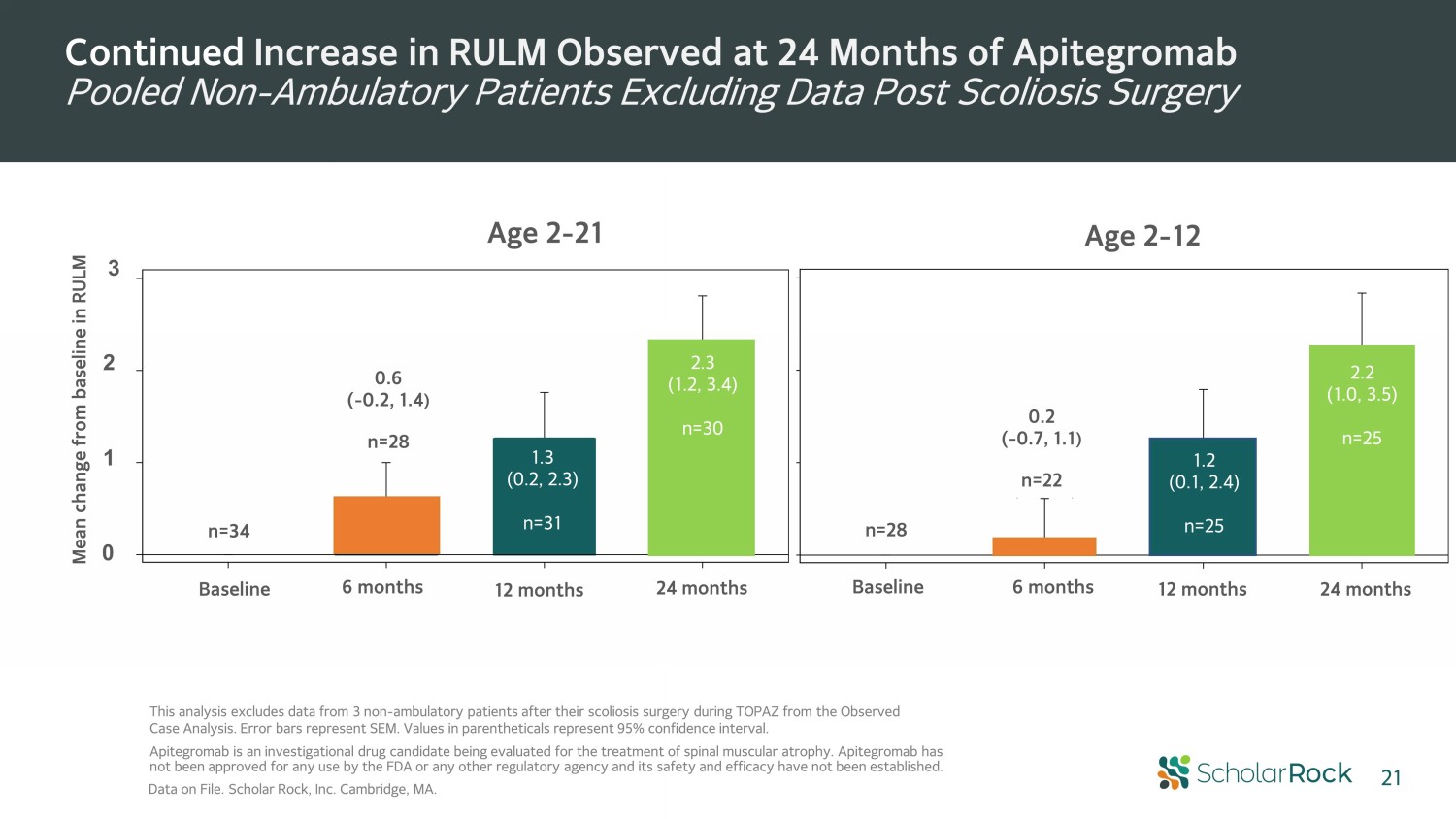
Continued Increase in RULM Observed at 24 Months of Apitegromab Pooled Non - Ambulatory Patients Excluding Data Post Scoliosis Surgery Data on File. Scholar Rock, Inc. Cambridge, MA. This analysis excludes data from 3 non - ambulatory patients after their scoliosis surgery during TOPAZ from the Observed Case Analysis. Error bars represent SEM. Values in parentheticals represent 95% confidence interval. Age 2 - 21 Age 2 - 12 24 months 12 months 6 months n=28 0 1 2 3 21 0.2 ( - 0.7, 1.1 ) n=22 Baseline 24 months 12 months 6 months 0.6 ( - 0.2, 1.4 ) n=28 Baseline n=34 Mean change from baseline in RULM Apitegromab is an investigational drug candidate being evaluated for the treatment of spinal muscular atrophy. Apitegromab ha s not been approved for any use by the FDA or any other regulatory agency and its safety and efficacy have not been established . 2.2 (1.0, 3.5) n=25 2.3 (1.2, 3.4) n=30 1.2 (0.1, 2.4) n=25 1.3 (0.2, 2.3) n=31
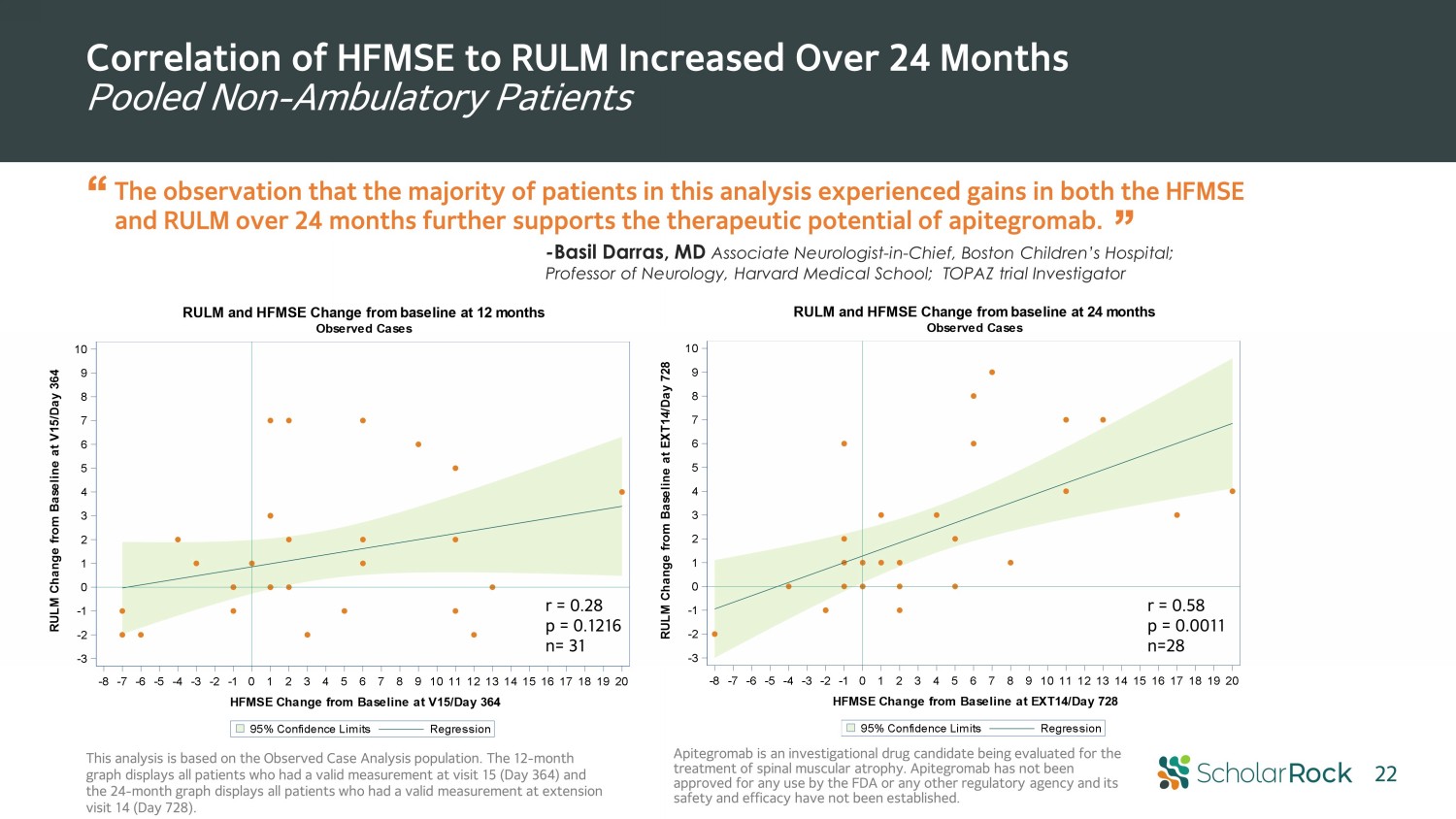
Correlation of HFMSE to RULM Increased Over 24 Months Pooled Non - Ambulatory Patients -8 -7 -6 -5 -4 -3 -2 -1 0 1 2 3 4 5 6 7 8 9 1011 1213 14 1516 1718 19 20 HFMSE Change from Baseline at EXT14/Day 728 -3 -2 -1 0 1 2 3 4 5 6 7 8 9 10 R U L M C h a n g e f r o m B a s e l i n e a t E X T 1 4 / D a y 7 2 8 Regression95% Confidence Limits RULM and HFMSE Change from baseline at 24 months Observed Cases -8 -7 -6 -5 -4 -3 -2 -1 0 1 2 3 4 5 6 7 8 9 1011 1213 14 1516 1718 19 20 HFMSE Change from Baseline at V15/Day 364 -3 -2 -1 0 1 2 3 4 5 6 7 8 9 10 R U L M C h a n g e f r o m B a s e l i n e a t V 1 5 / D a y 3 6 4 Regression95% Confidence Limits RULM and HFMSE Change from baseline at 12 months Observed Cases The observation that the majority of patients in this analysis experienced gains in both the HFMSE and RULM over 24 months further supports the therapeutic potential of apitegromab. r = 0.28 p = 0.1216 n= 31 r = 0.58 p = 0.0011 n=28 22 This analysis is based on the Observed Case Analysis population. The 12 - month graph displays all patients who had a valid measurement at visit 15 (Day 364) and the 24 - month graph displays all patients who had a valid measurement at extension visit 14 (Day 728). Apitegromab is an investigational drug candidate being evaluated for the treatment of spinal muscular atrophy. Apitegromab has not been approved for any use by the FDA or any other regulatory agency and its safety and efficacy have not been established. “ ” - Basil Darras, MD Associate Neurologist - in - Chief, Boston Children’s Hospital; Professor of Neurology, Harvard Medical School; TOPAZ trial Investigator

Therapeutic Potential of Apitegromab Observed in the Ambulatory Type 3 SMA Cohort at 24 Months Ambulatory Patients (Revised Hammersmith Scale; RHS) 24 Month Analysis Cohort 1 20 mg/kg pooled (n=21) 20 mg/kg monotherapy (n=11) 20 mg/kg + nusinersen (n=10) Mean change from baseline (95% CI) - 1.8 ( - 4.7, 1.1) - 2.8 ( - 8.4, 2.8) - 0.7 ( - 3.1, 1.7) # (%) pts achieving ≥1 - pt increase 9/21 (42.9%) 5/11 (45.5%) 4/10 (40%) # (%) pts achieving ≥3 - pt increase 5/21 (23.8%) 3/11 (27.3%) 2/10 (20%) Observed Case Analysis includes all patients who had a valid measurement at E14 (Day 728). Inclusive of data from 3 patients in apitegromab monotherapy who lost ability to ambulate. 23 Apitegromab is an investigational drug candidate being evaluated for the treatment of spinal muscular atrophy. Apitegromab has not been approved for any use by the FDA or any other regulatory agency and its safety and efficacy have not been established.
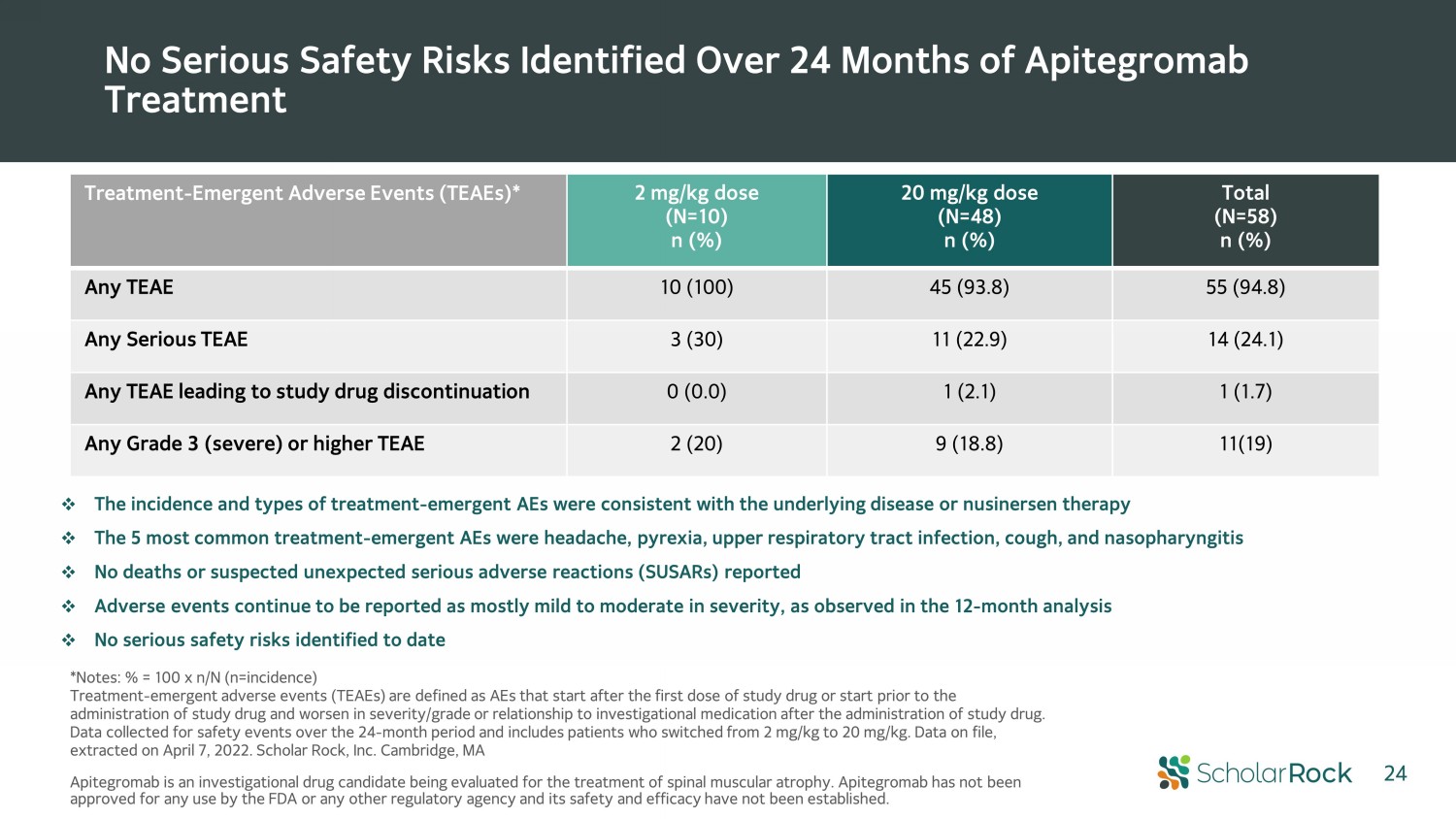
No Serious Safety Risks Identified Over 24 Months of Apitegromab Treatment Treatment - Emergent Adverse Events (TEAEs)* 2 mg/kg dose (N=10) n (%) 20 mg/kg dose (N=48) n (%) Total (N=58) n (%) Any TEAE 10 (100) 45 (93.8) 55 (94.8) Any Serious TEAE 3 (30) 11 (22.9) 14 (24.1) Any TEAE leading to study drug discontinuation 0 (0.0) 1 (2.1) 1 (1.7) Any Grade 3 (severe) or higher TEAE 2 (20) 9 (18.8) 11(19) □ The incidence and types of treatment - emergent AEs were consistent with the underlying disease or nusinersen therapy □ The 5 most common treatment - emergent AEs were headache, pyrexia, upper respiratory tract infection, cough, and nasopharyngitis □ No deaths or suspected unexpected serious adverse reactions (SUSARs) reported □ Adverse events continue to be reported as mostly mild to moderate in severity, as observed in the 12 - month analysis □ No serious safety risks identified to date *Notes: % = 100 x n/N (n=incidence) Treatment - emergent adverse events (TEAEs) are defined as AEs that start after the first dose of study drug or start prior to the administration of study drug and worsen in severity/grade or relationship to investigational medication after the administrat ion of study drug. Data collected for safety events over the 24 - month period and includes patients who switched from 2 mg/kg to 20 mg/kg. Data on file, extracted on April 7, 2022. Scholar Rock, Inc. Cambridge, MA 24 Apitegromab is an investigational drug candidate being evaluated for the treatment of spinal muscular atrophy. Apitegromab ha s n ot been approved for any use by the FDA or any other regulatory agency and its safety and efficacy have not been established.

Summary of TOPAZ Extension Period: 24 - Month Data Sustained Benefit and Evidence of Continued Improvement □ Non - Ambulatory Types 2/3 SMA • Motor function associated with activities of daily living improved with apitegromab + nusinersen at 24 months: o Sizable and sustained gains in HFMSE scores observed o Continued increase in Revised Upper Limb Module (RULM) scores observed o Dose response observed over 24 months, with evidence of further motor function gains as low - dose patients switch to high - dose in extension period ( 2 mg/kg to 20 mg/kg) □ Ambulatory Type 3 SMA • Stability of Revised Hammersmith Scale (RHS) in patients receiving 20 mg/kg of apitegromab + nusinersen • Potential motor function gains in subgroups □ No serious safety risks identified to date • Five most common treatment - emergent adverse events (TEAEs) were headache, pyrexia, upper respiratory tract infection, cough, and nasopharyngitis • Incidence and types of TEAEs were consistent with underlying disease or nusinersen therapy □ Detailed analyses to be presented at Cure SMA (June 2022) 25 Apitegromab is an investigational drug candidate being evaluated for the treatment of spinal muscular atrophy. Apitegromab has not been approved for any use by the FDA or any other regulatory agency and its safety and efficacy have not been established.

Ongoing SAPPHIRE Phase 3 Trial Overview • Randomized, double - blind, placebo - controlled, parallel arm design • Enrolling patients on SMN therapy (nusinersen or risdiplam ) • Primary efficacy endpoint: mean HFMSE change from baseline at 12 months • Study start - up activities commenced Apitegromab (20 mg/kg IV q4w) + SMN upregulator Main Population Patients (age 2 - 12) with non - ambulatory Types 2 and 3 SMA 52 weeks treatment Apitegromab (10 mg/kg IV q4w) + SMN upregulator Placebo + SMN upregulator N = 52 N = 52 N = 52 26
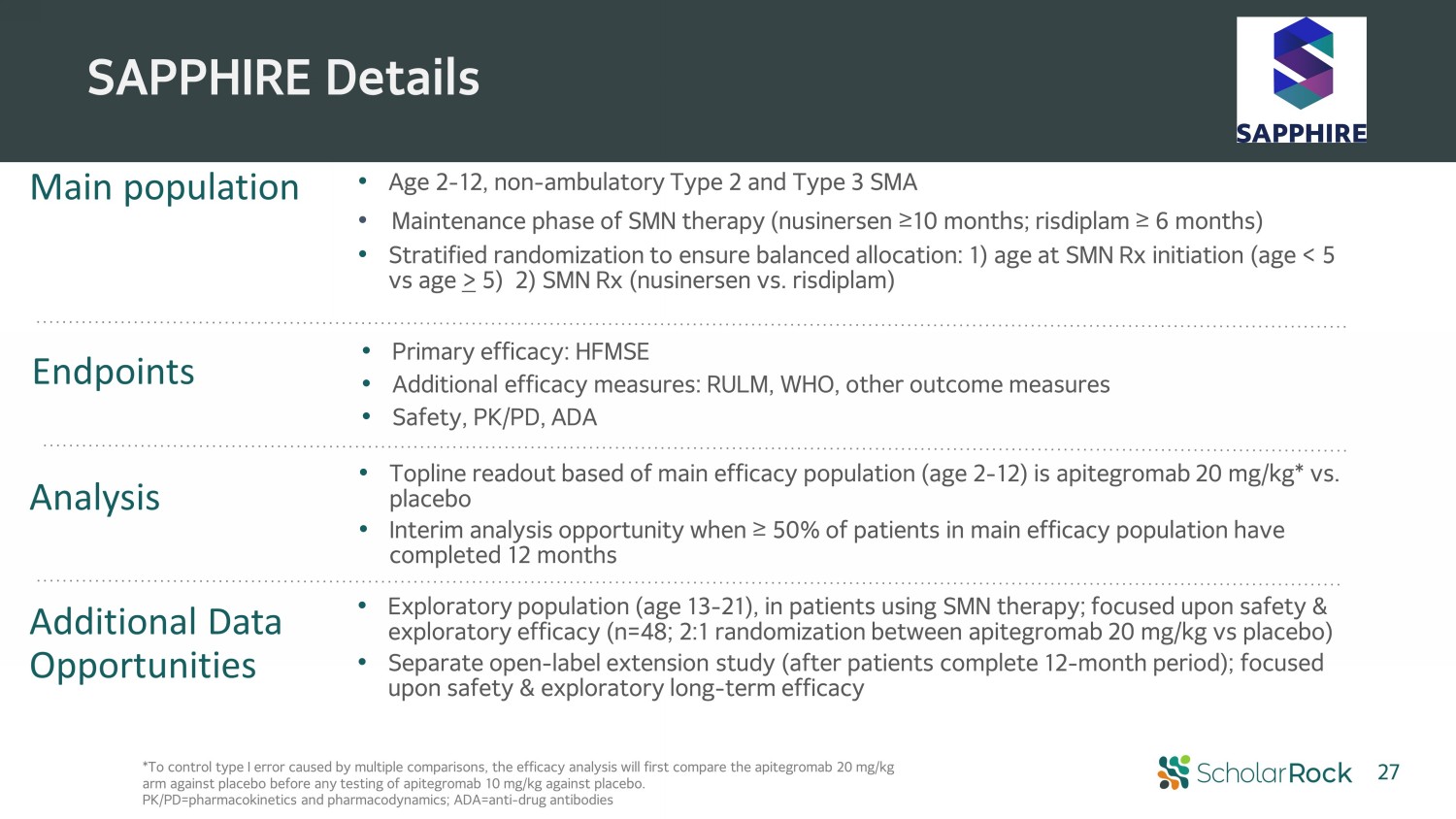
SAPPHIRE Details Main population Endpoints Analysis Additional Data Opportunities • Primary efficacy: HFMSE • Additional efficacy measures: RULM, WHO, other outcome measures • Safety, PK/PD, ADA • Topline readout based of main efficacy population (age 2 - 12) is apitegromab 20 mg/kg* vs. placebo • Interim analysis opportunity when ≥ 50% of patients in main efficacy population have completed 12 months • Exploratory population (age 13 - 21), in patients using SMN therapy; focused upon safety & exploratory efficacy (n=48; 2:1 randomization between apitegromab 20 mg/kg vs placebo) • Separate open - label extension study (after patients complete 12 - month period); focused upon safety & exploratory long - term efficacy • Age 2 - 12, non - ambulatory Type 2 and Type 3 SMA • Maintenance phase of SMN therapy (nusinersen ≥10 months; risdiplam ≥ 6 months) • Stratified randomization to ensure balanced allocation: 1) age at SMN Rx initiation (age < 5 vs age > 5) 2) SMN Rx (nusinersen vs. risdiplam) *To control type I error caused by multiple comparisons, the efficacy analysis will first compare the apitegromab 20 mg/kg arm against placebo before any testing of apitegromab 10 mg/kg against placebo. PK/PD=pharmacokinetics and pharmacodynamics; ADA=anti - drug antibodies 27

Focused Pipeline of Novel Product Candidates 28 Discovery - stage pipeline focused on the selective modulation of growth factor signaling APITEGROMAB SRK - 181 A selective inhibitor of myostatin activation being developed as the potential first muscle - directed therapy for the treatment of spinal muscular atrophy (SMA) in multiple clinical trials • Phase 2 TOPAZ study (extension portion ongoing) • Phase 3 SAPPHIRE trial A selective inhibitor of latent TGFβ1 activation being developed with the aim of overcoming primary resistance to and increasing the number of patients who may benefit from checkpoint inhibitor therapy • Potential to become the next transformative therapy for cancer patients • Phase 1 DRAGON (Part B ongoing) Potential to transform the lives of patients suffering from a wide range of serious diseases, including neuromuscular disorders, cancer, and fibrosis Phase 3 Pivotal Trial Phase 1 Proof of Concept Trial 28
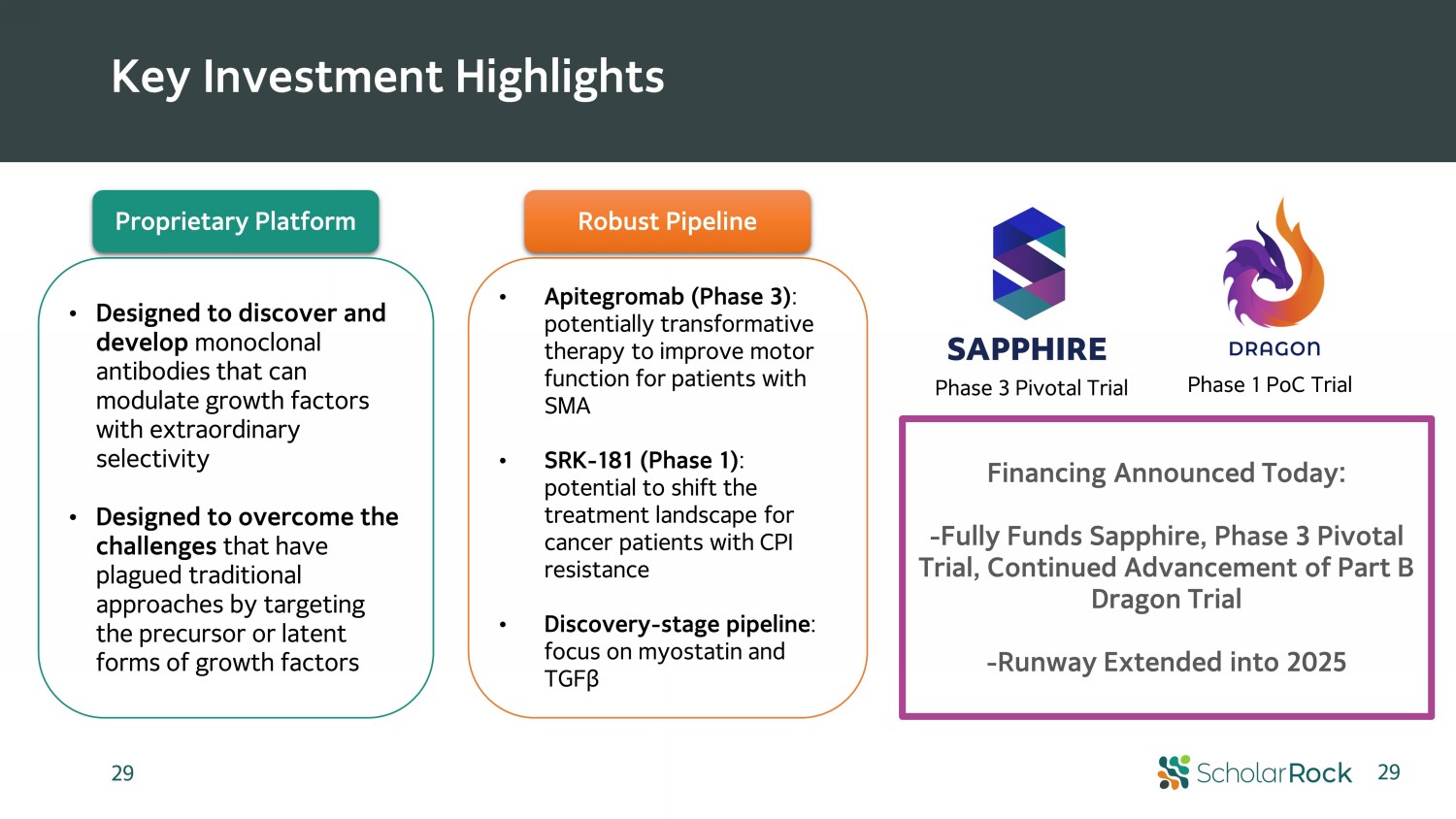
Key Investment Highlights 29 • Designed to discover and develop monoclonal antibodies that can modulate growth factors with extraordinary selectivity • Designed to overcome the challenges that have plagued traditional approaches by targeting the precursor or latent forms of growth factors • Apitegromab (Phase 3) : potentially transformative therapy to improve motor function for patients with SMA • SRK - 181 (Phase 1) : potential to shift the treatment landscape for cancer patients with CPI resistance • Discovery - stage pipeline : focus on myostatin and TGFβ Proprietary Platform Robust Pipeline Phase 3 Pivotal Trial Phase 1 PoC Trial Financing Announced Today: - Fully Funds Sapphire, Phase 3 Pivotal Trial, Continued Advancement of Part B Dragon Trial - Runway Extended into 2025 29

30 Appendix

Strong Evidence of Dose Response Observed Over 24 Months Further Supported by Data from Low Dose to High Dose Switch 31 Most patients in Cohort 3 who switched from 2 mg/kg to 20 mg/kg continued to show HFMSE improvement Study day is relative to the date of the first dose of 20 mg/kg Study Day Patient with scoliosis surgery Rapid increase Benefit maintained through 24 - month timepoint Gradual increases of HFMSE at 2 mg/kg Continued improvement after switch Apitegromab is an investigational drug candidate being evaluated for the treatment of spinal muscular atrophy. Apitegromab ha s n ot been approved for any use by the FDA or any other regulatory agency and its safety and efficacy have not been established.
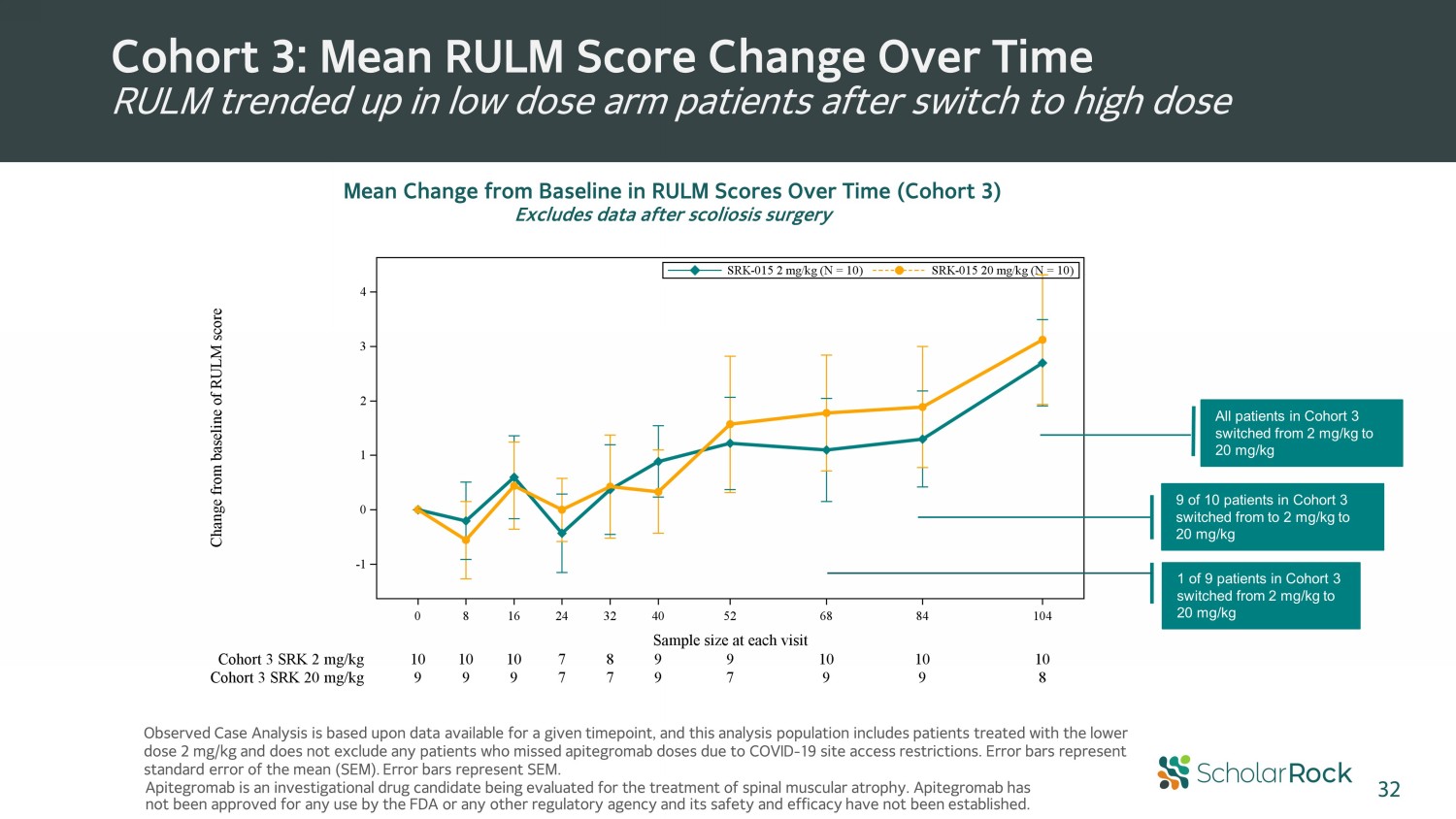
Cohort 3: Mean RULM Score Change Over Time RULM trended up in low dose arm patients after switch to high dose All patients in Cohort 3 switched from 2 mg/kg to 20 mg/kg 1 of 9 patients in Cohort 3 switched from 2 mg/kg to 20 mg/kg 9 of 10 patients in Cohort 3 switched from to 2 mg/kg to 20 mg/kg Figure 14.2.1.3.1 Mean (+/- 1 SE) change from baseline in RULM total score over time Sensitivity Analysis: Excluding measurements after scoliosis surgery Cohort 3 32 Observed Case Analysis is based upon data available for a given timepoint, and this analysis population includes patients tre ate d with the lower dose 2 mg/kg and does not exclude any patients who missed apitegromab doses due to COVID - 19 site access restrictions. Error bars represent standard error of the mean (SEM). Error bars represent SEM. Apitegromab is an investigational drug candidate being evaluated for the treatment of spinal muscular atrophy. Apitegromab ha s not been approved for any use by the FDA or any other regulatory agency and its safety and efficacy have not been established . Mean Change from Baseline in RULM Scores Over Time (Cohort 3) Excludes data after scoliosis surgery
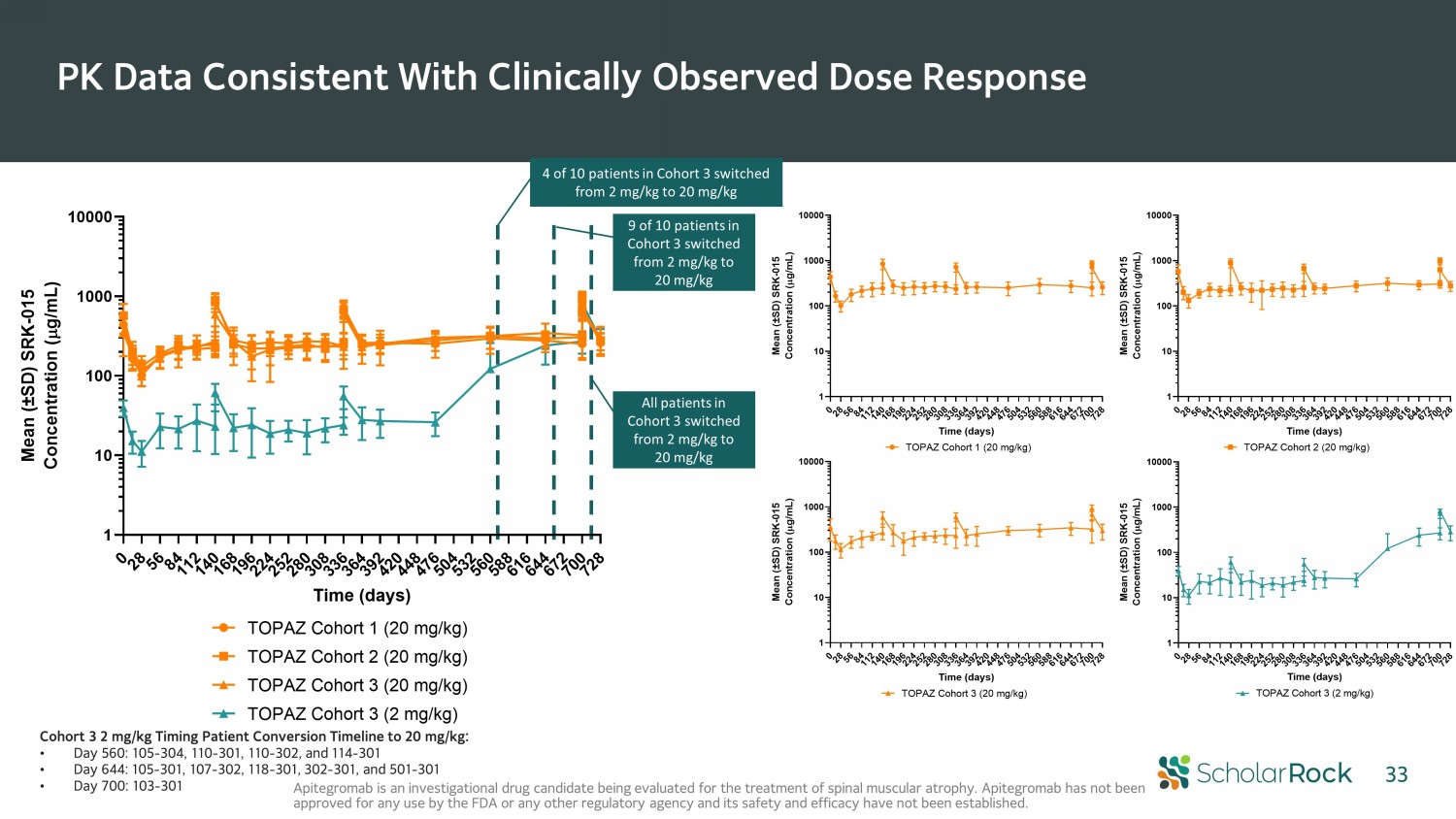
4 of 10 patients in Cohort 3 switched from 2 mg/kg to 20 mg/kg 9 of 10 patients in Cohort 3 switched from 2 mg/kg to 20 mg/kg All patients in Cohort 3 switched from 2 mg/kg to 20 mg/kg Cohort 3 2 mg/kg Timing Patient Conversion Timeline to 20 mg/kg: • Day 560: 105 - 304, 110 - 301, 110 - 302, and 114 - 301 • Day 644: 105 - 301, 107 - 302, 118 - 301, 302 - 301, and 501 - 301 • Day 700: 103 - 301 0 2 8 5 6 8 4 1 1 2 1 4 0 1 6 8 1 9 6 2 2 4 2 5 2 2 8 0 3 0 8 3 3 6 3 6 4 3 9 2 4 2 0 4 4 8 4 7 6 5 0 4 5 3 2 5 6 0 5 8 8 6 1 6 6 4 4 6 7 2 7 0 0 7 2 8 1 10 100 1000 10000 Time (days) M e a n ( ± S D ) S R K - 0 1 5 C o n c e n t r a t i o n ( g / m L ) TOPAZ Cohort 1 (20 mg/kg) TOPAZ Cohort 2 (20 mg/kg) TOPAZ Cohort 3 (20 mg/kg) TOPAZ Cohort 3 (2 mg/kg) 0 2 8 5 6 8 4 1 1 2 1 4 0 1 6 8 1 9 6 2 2 4 2 5 2 2 8 0 3 0 8 3 3 6 3 6 4 3 9 2 4 2 0 4 4 8 4 7 6 5 0 4 5 3 2 5 6 0 5 8 8 6 1 6 6 4 4 6 7 2 7 0 0 7 2 8 1 10 100 1000 10000 Time (days) M e a n ( ± S D ) S R K - 0 1 5 C o n c e n t r a t i o n ( g / m L ) TOPAZ Cohort 1 (20 mg/kg) 0 2 8 5 6 8 4 1 1 2 1 4 0 1 6 8 1 9 6 2 2 4 2 5 2 2 8 0 3 0 8 3 3 6 3 6 4 3 9 2 4 2 0 4 4 8 4 7 6 5 0 4 5 3 2 5 6 0 5 8 8 6 1 6 6 4 4 6 7 2 7 0 0 7 2 8 1 10 100 1000 10000 Time (days) M e a n ( ± S D ) S R K - 0 1 5 C o n c e n t r a t i o n ( g / m L ) TOPAZ Cohort 3 (20 mg/kg) PK Data Consistent With Clinically Observed Dose Response 33 Apitegromab is an investigational drug candidate being evaluated for the treatment of spinal muscular atrophy. Apitegromab ha s n ot been approved for any use by the FDA or any other regulatory agency and its safety and efficacy have not been established.

TOPAZ Extension Period: 24 - Month Patient Disposition 34 Cohort 1 Ambulatory Non – Ambulatory Cohort 2 Cohort 3 Total # Non - Ambulatory Patients (2 - 21) 15 20 35 # Non - Ambulatory Patients (2 - 12) 9 20 29 Dropped Out (0 - 12 M) 1 0 0 0 Dropped Out (12 - 24 M) 1 1 1 Not Having Valid HFMSE testing at Month 24 Not applicable 5* 1** 6 Not Having RULM at Month 24 Not applicable 2*** 1**** 3 # of patients scoliosis surgery 1 2***** 1 3 *Includes 1 patient who withdrew from study; 1 patient off schedule due to scheduled surgery; 1 patient who had hip pain; 1 p ati ent with femur fracture; and 1 patient who refused to be in supine position. **Patient with bilateral lower extremity cast ***Includes 1 patient withdrew from study, and 1 patient off schedule due to planned surgery. ****Patient was too young for RULM at baseline and RULM was not conducted at following visit. *****Patients did not have valid HFMSE test at 24 months. 34

Overall Safety and Tolerability Profile Over 24 Months of Treatment: Serious TEAEs 35 • Fourteen patients experienced a serious TEAE, all assessed by the respective trial investigator as unrelated to apitegromab : o One patient treated with 2 mg/kg dose (Cohort 3) was hospitalized due to adenoidal hypertrophy and tonsillar hypertrophy to perform scheduled adenotonsillectomy (Grade 2). Events resolved without sequelae. o Two patients treated with 20 mg/kg dose (both Cohort 1) presented with gait inability considered a significant disability (both Grade 3). Events remain ongoing. o One patient treated with 20 mg/kg dose (Cohort 1) was hospitalized with post lumbar puncture syndrome (Grade 2). Event resolved without sequelae. o One patient treated with 20 mg/kg dose (Cohort 1) was hospitalized due to viral upper respiratory tract infection (Grade 2). Event resolved without sequelae. o Five patients treated with 20 mg/kg dose (one from Cohort 1, three from Cohort 2, and one from Cohort 3) were hospitalized for spinal fusion surgery/ scoliosis/ scoliosis surgery (all Grade 3). All events resolved without sequelae. o One patient treated with 20 mg/kg dose (Cohort 1) was hospitalized due to bilateral developmental hip dysplasia and left hip dislocation (both Grade 3). Events resolved without sequelae. o One patient treated with 2 mg/kg dose (Cohort 3) was hospitalized due to hip dislocation (Grade 3). Event resolved with sequelae (anxiety and post - operative pain). o One patient treated with 20 mg/kg dose (Cohort 3) was hospitalized due to respiratory syncytial virus infection (Grade 2). Events resolved without sequelae. o One patient treated with 2 mg/kg dose (Cohort 3) was hospitalized due to vomiting and pneumonia (Grade 3). Events resolved without sequelae.

Overall Safety and Tolerability Profile Over 24 Months of Treatment: Non - Serious Grade 3 Events 36 • Four patients presented with non - serious Grade 3 events, all assessed by the respective trial investigator as unrelated to apitegromab : o One patient treated with 20 mg/kg dose (Cohort 1) presented with post lumbar puncture syndrome. Event resolved without sequelae. o One patient treated with 20 mg/kg dose (Cohort 2) presented with worsening of scoliosis. Event resolved (with surgery, reported as serious, above) without sequelae. o One patient treated with 20 mg/kg dose (Cohort 2) presented with osteopenia. Events remains ongoing. o One patient treated with 2 mg/kg (Cohort 3) presented with two instances of hypoglycemia and one instance of metabolic acidosis. All events resolved without sequelae. o One patient (Cohort 1) discontinued from the trial due to Grade 2 muscle fatigue that started prior to initiation of dosing with study drug; assessed by the trial investigator as unrelated to apitegromab .



































